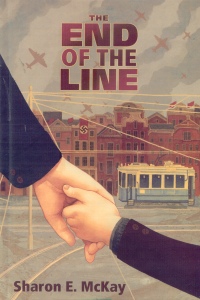| ________________
CM . . . . Volume XXI Number 8 . . . . October 24, 2014
excerpt:
In the The End of the Line, a Jewish mother and daughter are on the run in German-occupied Amsterdam as they seek a new hiding place. While on a tram, the mother is escorted off by a Nazi soldier for failing to have the correct papers. When the Nazi soldier tells the little girl to come with him as well, the ticket collector interjects, saying that she is his niece. The tram driver, his brother, is surprised but does not refute the claim, and the small child completes the rest of the day's route with them. At the end of their shift, they determine that they will take the little girl to their neighbour's house as the older bachelors know nothing about children. However, Mrs. Vo, their neighbour, more fully understands the gravity of their actions and insists that they will be the ones to provide primary care for the young girl. Mrs. Vo does ensure that their neighbours won't inform the Nazis that their "niece" is staying with them and provides the brothers instructions on how to take care of the child. In this process, she also enlists a young woman on their street to help teach Beatrix about Catholicism. With Beatrix now in their care, Lars and Hans make it a priority to listen and learn more about the Nazis in their community and do what they can in order to protect those endangered on their tram. As the war progresses, Beatrix grows, as do the dangers that she faces, and she loses yet another individual close to her due to the Nazis. Throughout the bombings, cold, poverty and hunger, she still holds out hope that she once again will be reunited with her mother. In The End of the Line, readers will be interested in the way that the brothers originally felt towards the Germans who invaded Holland. Living in Canada more than half a century after World War II, it is near impossible to view the actions of the Nazis with any degree of uncertainty due to their position against the Jewish people. However, by viewing the war through Lars' and Hans' eyes, readers realize what little information civilians had access to at the beginning of the war. Hans and Lars initially viewed the Germans with some esteem as, while they had invaded Holland, they were still European, which meant for the Dutch brothers that the Nazis must be civilized to some degree. Additionally, as the German troops had initially been instructed to treat the Holland's non-Jewish population quite well, it was a very confusing time for the brothers. Readers will relate to how the war changed the brothers' perspective. In the book, Lars and Hans realize that they must stay informed about the Germans' actions in their nation in order to best protect Beatrix, the child they have grown to love as their own family, in addition to being loyal to their fellow citizens. The concern that the brothers have for both Beatrix's emotional and physical well-being is particularly stirring, as well as the hope that Beatrix holds for the return of her mother. Some of the losses that Beatrix and the brothers face in the story are quite painful, but not so graphic that older children would be overwhelmed. Rather, these events allow younger readers to develop an understanding of the some of the tragedies that impacted civilians during the Second World War. Readers, as they learn of Beatrix's non-Jewish heritage and the response her paternal grandparents had towards her, may be surprised to find how quickly even families turned on one another due to the fear that the Nazis inspired. The author divides the book into different seasons and years and captures only selected events that occur during of the noted periods of time. This method of story telling is very helpful for readers to understand the different types of difficulties that civilians faced over the five years that Holland was occupied by Germany. The challenges for the characters ranged from being threatened by the Nazis, to bombings, to forced labour, to starvation, and cold. The author provides a foreword and an afterword which provide additional background to readers regarding Holland's particular situation in the war, as it was invaded May 10, 1940, without receiving a formal declaration of war. This information enriches the story and is the appropriate length and depth for the intended audience. Overall, The End of the Line provides an excellent description of what life must have felt like for civilians in Holland during World War II while still being very sweet, due to the loving and caring relationships Beatrix forms with her guardians in the absence of her mother. Highly Recommended. Meredith Harrison Lim is a MLIS graduate working for the Federal Government in the National Capital Region. Copyright © the Manitoba Library Association. Reproduction for personal use is permitted only if this copyright notice is maintained. Any other reproduction is prohibited without permission.
Next Review |
Table of Contents for This Issue
- October 24, 2014. |
